art | architecture | design | gallery | illustration | music | painting | photography | sculpture | video

Retouches photo avec Photoshop (French) by Cyril Bruneau
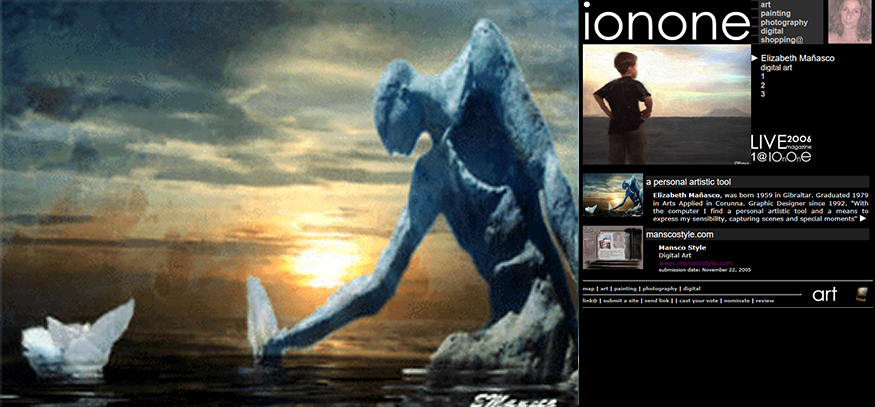
Elizabeth Mañasco, was born 1959 in Gibraltar. Graduated 1979 in Arts Applied in Corunna. Graphic Designer since 1992.
"With the computer I find a personal artistic tool and a means to express my sensibility, capturing scenes and special moments"
read more »
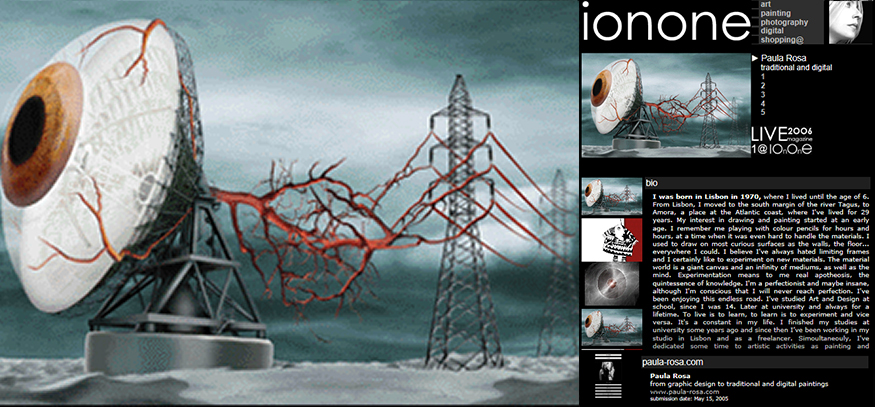
I was born in Lisbon in 1970, where I lived until the age of 6. From Lisbon, I moved to the south margin of the river Tagus, to Amora, a place at the Atlantic coast, where I've lived for 29 years. My interest in drawing and painting started at an early age. I remember me playing with colour pencils for hours and hours, at a time when it was even hard to handle the materials. I used to draw on most curious surfaces as the walls, the floor... everywhere I could. I believe I've always hated limiting frames and I certainly like to experiment on new materials. The material world is a giant canvas and an infinity of mediums, as well as the mind. Experimentation means to me real apotheosis, the quintessence of knowledge. I'm a perfectionist and maybe insane, although I'm conscious that I will never reach perfection. I've been enjoying this endless road. I've studied Art and Design at school, since I was 14. Later at university and always for a lifetime. To live is to learn, to learn is to experiment and vice versa. It's a constant in my life. I finished my studies at university some years ago and since then I’ve been working in my studio in Lisbon and as a freelancer. Simoultaneouly, I've dedicated some time to artistic activities as painting and sculpture. In 2003, as I was conscious of the importance of digital technologies and how they revolutionize the arts, I started experimenting several techniques in digital painting or mixed medium (traditional/digital). I believe that a new aestetics has grown and expanded from the digital media, allowing the artist more freedom during the creative act, in which the computer represents both, the material and the medium, being a powerful tool as fast as imagination. It's not easy to answer when I'm asked to define my art in a few words. I've always faced it as “... a product of dreams with eyes opened widely, a journey through the human brain, exploring its darker places, opening imaginary doors to empty imaginary rooms... or maybe not.” I'm a member of ARTES- Seixal Cultural Association and member of Surrealists (Surrealist International). I'm represented in several national and international exhibitions and I've some permanent galleries online
www.paula-rosa.com
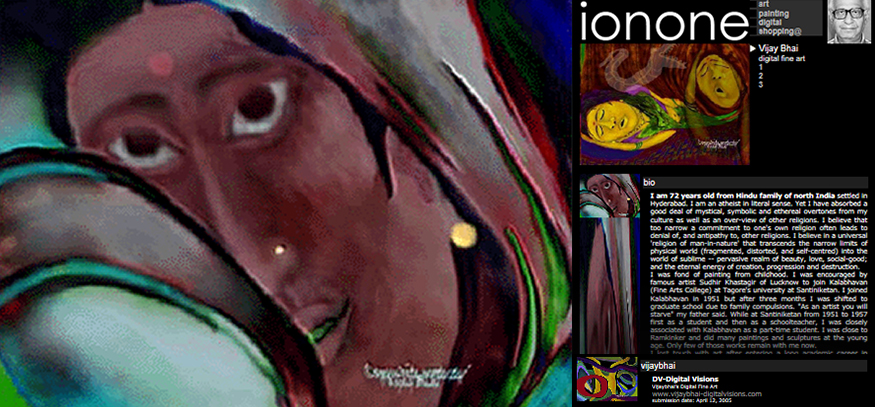
I am 72 years old from Hindu family of north India settled in Hyderabad. I am an atheist in literal sense. Yet I have absorbed a good deal of mystical, symbolic and ethereal overtones from my culture as well as an over-view of other religions. I believe that too narrow a commitment to one's own religion often leads to denial of, and antipathy to, other religions. I believe in a universal 'religion of man-in-nature' that transcends the narrow limits of physical world (fragmented, distorted, and self-centred) into the world of sublime -- pervasive realm of beauty, love, social-good; and the eternal energy of creation, progression and destruction.
I was fond of painting from childhood. I was encouraged by famous artist Sudhir Khastagir of Lucknow to join Kalabhavan (Fine Arts College) at Tagore's university at Santiniketan. I joined Kalabhavan in 1951 but after three months I was shifted to graduate school due to family compulsions. "As an artist you will starve" my father said. While at Santiniketan from 1951 to 1957 first as a student and then as a schoolteacher, I was closely associated with Kalabhavan as a part-time student. I was close to Ramkinker and did many paintings and sculptures at the young age. Only few of those works remain with me now.
I lost touch with art after entering a long academic career in social science. After studying literature (M.A., Visva Bharati) and anthropology (M.A., Ph.D. at Lucknow University), I specialised in Medical Sociology abroad (D.Sc. Johns Hopkins University). I spent time whole-heartedly for research and teaching at five different universities including Johns Hopkins University and Howard University. I was in USA for 6 years and returned to Banaras Hindu University in 1976. I shifted to Central University, Hyderabad from BHU in 1979. I retired as Professor of sociology in 1994.
The highlight of my academic career was to study and promote the folk culture and practices of ordinary villagers - first in the field of health, hygiene and sanitation, and then in the field of forestry and watershed development. Understanding the richness and limitations of folk culture, and then facilitating development through active and direct participation of primary stakeholders, was my obsession. Despite a lot of lip service and private appreciation of participatory development, this is totally against the mainstream of administration and professions in India. Except for small-scale glimpses of the potential and possibilities of such an approach, particularly when working with voluntary agencies, I was a lone crusader and failed to get support of institutions, administrators & professionals in my mission. But for few close friends and colleagues who worked with me and understood me (or did they?), it was an exciting battle.
Getting back to my private world of fine art was a healing consolation for my aging self.
An exoposure to the works of great variety of digital artist on the internet, including Pygoya and Ingrid Kamerbeek has opened my eyes to the vast arena of cyber-art. They have encouraged me. I have visited digital art sites on the Internet and I am overwhelmed by the variety, depth and complexity of the digital art today. I am still learning and exploring the possibilities of the digital medium. What I have done so far is nothing but a beginning.
Here again perhaps I am up against the mainstream by choosing the digital medium and calling myself an 'artist'. What matters is that I thoroughly enjoy what I am doing. It fills my life with a sense of fulfilment. It has charged the lonely life of an aged widower.
Like all artists I like to share and learn what others have to say. During last one year I have displayed my works in a number of art related web sites. It is time I have my own website.
www.vijaybhai-digitalvisions.com

Mohammed Sherif born 11 March 1978 in Egypt. Hobbies : guitar, singing, movies. Education : BSC of Computer Engineering. Skills : Adobe Photoshop, Freehand, Flash, Html, Director Graphic Design & Web Design, Digital Art.
www.is.msherif.com
Jürgen Schmitz grew up in Cologne, Germany, and now lives and works in Ancona, Italy. Complete artist, Schmitz only recently decided to dedicate himself to digital art making in a professional way. Thanks to his vivid imagination, he creates works in which he combines formal compositions and various chromatic tones with singular textures of often materic effects. It's essential to the author creating his works with instantaneousness; all his works, unique and never reproduced more than once, are similar to 'snapshots': their birth, their elaboration and their realization is performed in a short time frame in order to take the best advantage from the immediacy, the instant, the magic intuitive and inventive moment.
Each phase of the creative process is personally followed with care and precision by the artist; like an 'artisan', he creates and produces his artwork up to the final part of the printing. Schmitz, inventor artist, gets inspiration by the experiences coming from his job in management for an international company, maker of electronic musical instruments, but, above all, by his innate and inexhaustible nature of creative, of searcher; his works reveal and introduce us in a world made of colours, figures, compositions and architectures, all products of an imaginative and immediate path.
Paola Trevisan
www.ad-esso.com
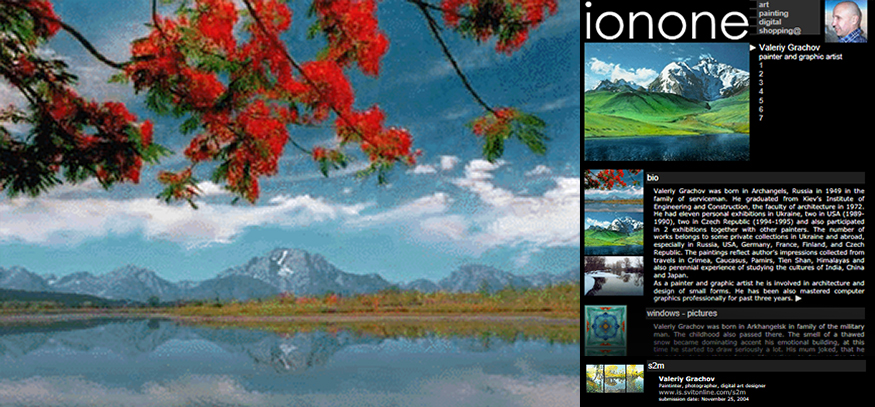
Valeriy Grachov was born in Archangelsk, Russia in 1949. He went to school in Leningrad in 1956 and later moved to Dnepropetrovsk, Ukraine with the family. He graduated from high school in Kiev and entered Kiev’s Institute of Design and Architecture in 1966 with following graduation in 1972. The artist travelled, resided and worked in many places over mountains in Central Asia, Baikal, Far East, on the islands in Japanese Sea. He lived and worked in Jyvaskyla (Finland) in 1988, Trenton (USA) in 1989-90, Prague (Czech Rep.) in 1974-75. Presently lives in Kiev, Ukraine. read more »
www.valeriygrachov.kiev.ua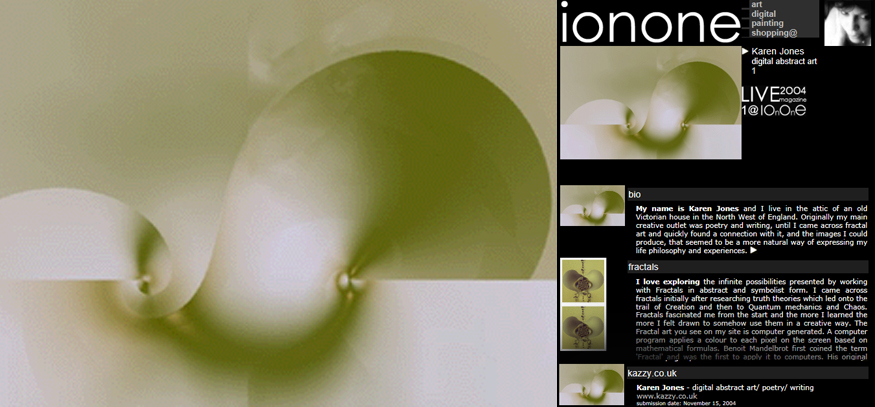
My name is Karen Jones and I live in the attic of an old Victorian house in the North West of England. Originally my main creative outlet was poetry and writing, until I came across fractal art and quickly found a connection with it, and the images I could produce, that seemed to be a more natural way of expressing my life philosophy and experiences.
I love exploring the infinite possibilities presented by working with Fractals in abstract and symbolist form. I came across fractals initially after researching truth theories which led onto the trail of Creation and then to Quantum mechanics and Chaos. Fractals fascinated me from the start and the more I learned the more I felt drawn to somehow use them in a creative way. The Fractal art you see on my site is computer generated. A computer program applies a colour to each pixel on the screen based on mathematical formulas. Benoit Mandelbrot first coined the term 'Fractal' and was the first to apply it to computers. His original formula, z^2+c, is called the Mandelbrot formula.
www.kazzy.co.uk
November 18, 2004 From: Emma Kirk
This work is amazing, creative and touches the soul. I believe her work will be enjoyed by many more individuals worldwide in the near future. Thanks to the magazine for allowing people to view the work of this unbelievable artist. Regards
November 17, 2004 From: Robert Maxwell
Karen Jones has taken technology into the realm of the sensuous. Whoever thought pixels could be so evocative? Marvelous work.
November 17, 2004 From: Stephen Whitehead
I'm so pleased to see you featuring Karen Jones' artwork on your site...it's a real tribute to your magazine, as I feel her work will change the world. Thank you. Stephen Whitehead
November 17, 2004 From: G Emil Reutter
Editors: I greatly enjoyed the presentation of the digital art of Karen Jones in your recent issue. The passion of this artist generates forth from each work of art produced and leaves the viewer wanting more. Thanks for presenting Ms. Jones in your magazine. Very truly yours, G Emil Reutter
November 17, 2004 From: Amanda Roberts
What a wonderful artist, the images are perfect and intriguing and unlike any I have ever seen! Good exposure, and I hope to buy prints soon.
Congratulations Karen Jones!
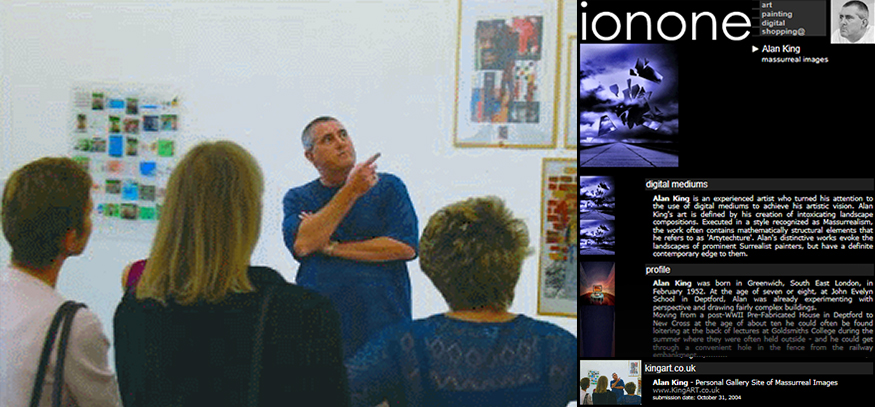
Alan King was born in Greenwich, South East London, in February 1952. At the age of seven or eight, at John Evelyn School in Deptford, Alan was already experimenting with perspective and drawing fairly complex buildings.
Moving from a post-WWII Pre-Fabricated House in Deptford to New Cross at the age of about ten he could often be found loitering at the back of lectures at Goldsmiths College during the summer where they were often held outside - and he could get through a convenient hole in the fence from the railway embankment ...
When he went to ELTHAM GREEN SCHOOL in 1963 (pictured below) he was lucky enough to have teachers who, although teaching the disciplines of Art, allowed the students to develop their own styles. It was here he invented the word ARTYTECTURE to describe his style of work.
It was at Eltham Green that Alan was introduced to the Art of Dali, Tanguy, Reutersvard and Escher, plus the architecture of the great Frank Lloyd-Wright (all a great influence)
Leaving school in 1968 with just "O" Level Art he pursued a career in commercial Art with an Advertising agency in London's West End: Disappointingly, his commercial art career was cut short when he was transferred to the accounts Department and he left shortly afterwards. He was lucky enough to get some commissions during the Late 60's and early 70’s and exhibited and sold his work in local shows in London. He was fairly loose about the whole thing and has no idea where any of them are.
He moved away from London in 1977 and now lives in Milton Keynes, Bucks, England. His current style of artwork only really developed in January of 1999 when he decided to experiment with combining photography with his ARTYTECTURE with the aid of computer software. The rest, as they say, is History
In August 2002 Alan founded MILTON KEYNES DIGITAL ARTISTS and held the post of Chairman from August 2002 until May 2004. He regularly exhibits in and around Milton Keynes and is proud to be invited to attend schools as Artist-in-Residence for special projects
January 31, 2005 From: Rodica Sandra Miller
Your work is so wonderful, Alan.....Congratulations for this spectacular presentation at Ionone.
www.sandramillergalleries.com
www.KingART.co.uk
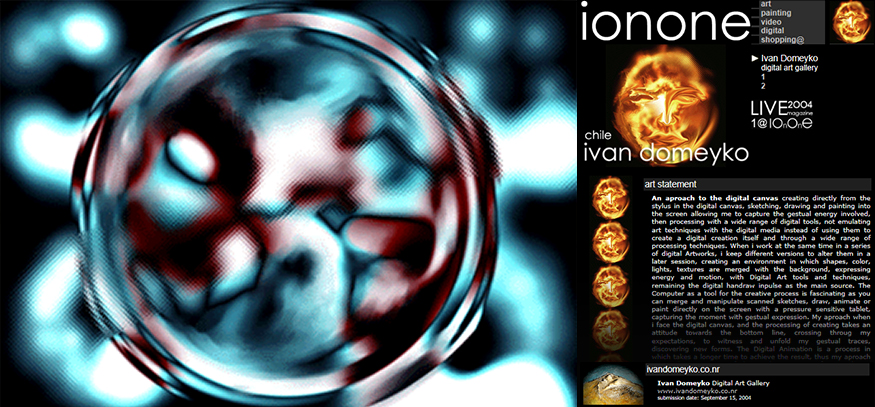
An aproach to the digital canvas creating directly from the stylus in the digital canvas, sketching, drawing and painting into the screen allowing me to capture the gestual energy involved, then processing with a wide range of digital tools, not emulating art techniques with the digital media instead of using them to create a digital creation itself and through a wide range of processing techniques. When i work at the same time in a series of digital Artworks, i keep different versions to alter them in a later session, creating an environment in which shapes, color, lights, textures are merged with the background, expressing energy and motion, with Digital Art tools and techniques, remaining the digital handraw inpulse as the main source. The Computer as a tool for the creative process is fascinating as you can merge and manipulate scanned sketches, draw, animate or paint directly on the screen with a pressure sensitive tablet, capturing the moment with gestual expression. My aproach when i face the digital canvas, and the processing of creating takes an attitude towards the bottom line, crossing throug my expectations, to witness and unfold my gestual traces, discovering new forms. The Digital Animation is a process in which takes a longer time to achieve the result, thus my aproach is a gathering process of ideas and images, transforming throug time and frames,a kinetic idea or script. The link between the still image and the moving picture comes when both became one, as you can see a still image but suggest you that is in motion, a parallel process in which both capture its essence. I have experience with digital video, stick figures drawings, old sci-fi movies, 3D, digital animated painting, exploring new ways to aproach digital Animation, in my own environment.
I have participated as a Computer Graphics Creative in Animation Films Festival since 1991 and recently at The Prix Ars Electronica (1998 ), Linz, Austria - The Darklight Digital Film Festival, Dublin, Ireland, ( 2000 ) - IFCT ( International Festival of Cinema and Technology ( 2002 ), Toronto, Canada, with the nominated Animated Shortfilm " The Rope". I have Lisenced in Fine Arts in Santiago, Chile Between 1981-1984, then Computer Graphics and Animation techniques at the CCAC in Berkley, San Francisco, USA(1985) - Sao Paulo, Brasil, ECA ( 1987) animation techniques, Computer Graphics at New York Institute of Technology NYIT, Computer Arts , USA ( 1988). Also i work as a Freelance Digital Artist / Animator /Designer in Film Productions, TV, Press, and i have showcase my digital Animations over Shortfilm Festivals and Internet.
www.ivandomeyko.co.nr

Obscura Machina seeks out the relics of the past imagined scenes, and unconscious states
A collaboration of two artists, our world is inspired by the time of the great machines of the industrial revolution, the experimental spirit of the early 20th century, of Victorian clutter and curios, explorations of the mind, and objects of mystery and marvel.
Utilising both traditional and digital techniques, our images reflect our passion for the eclectic, desire for the unknown, and the lost poetry of the forgotten and abandoned.
www.obscuramachina.com.au
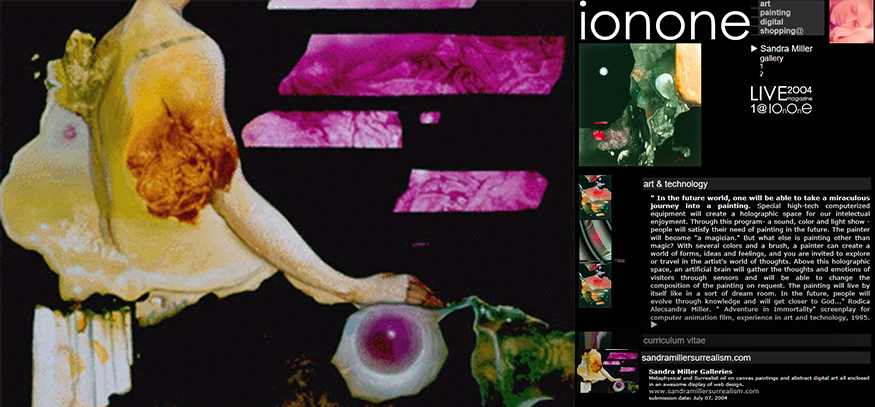
In the future world, one will be able to take a miraculous journey into a painting. Special high-tech computerized equipment will create a holographic space for our intelectual enjoyment. Through this program- a sound, color and light show - people will satisfy their need of painting in the future. The painter will become "a magician." But what else is painting other than magic? With several colors and a brush, a painter can create a world of forms, ideas and feelings, and you are invited to explore or travel in the artist's world of thoughts. Above this holographic space, an artificial brain will gather the thoughts and emotions of visitors through sensors and will be able to change the composition of the painting on request. The painting will live by itself like in a sort of dream room. In the future, people will evolve through knowledge and will get closer to God..." Rodica Alecsandra Miller. " Adventure in Immortality" screenplay for computer animation film, experience in art and technology, 1995.
www.sandramillersurrealism.com
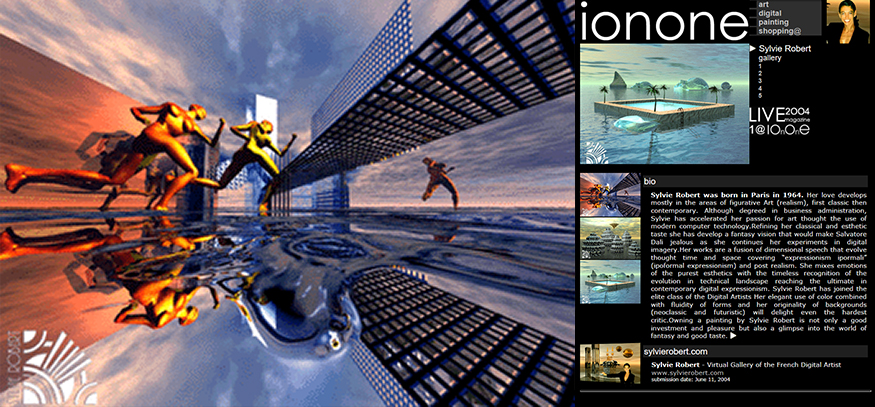
Sylvie Robert was born in Paris in 1964. Her love develops mostly in the areas of figurative Art (realism), first classic then contemporary. Although degreed in business administration, Sylvie has accelerated her passion for art thought the use of modern computer technology.Refining her classical and esthetic taste she has develop a fantasy vision that would make Salvatore Dali jealous as she continues her experiments in digital imagery.Her works are a fusion of dimensional speech that evolve thought time and space covering “expressionism ipormali” (ipoformal expressionism) and post realism. She mixes emotions of the purest esthetics with the timeless recognition of the evolution in technical landscape reaching the ultimate in contemporary digital expressionism. Sylvie Robert has joined the elite class of the Digital Artists Her elegant use of color combined with fluidity of forms and her originality of backgrounds (neoclassic and futuristic) will delight even the hardest critic. Owning a painting by Sylvie Robert is not only a good investment and pleasure but also a glimpse into the world of fantasy and good taste. read more »
www.sylvierobert.com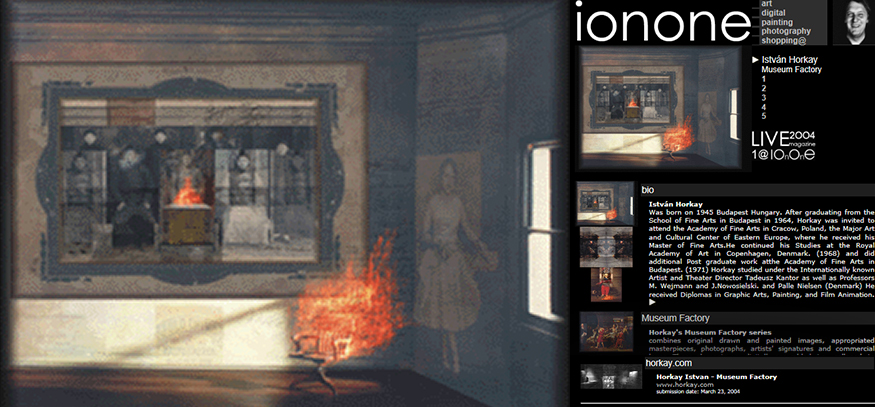
Horkay's Museum Factory series combines original drawn and painted images, appropriated masterpieces, photographs, artists' signatures and commercial logos. These elements are digitally assembled, i.e., collaged, to create a single, layered moment reflecting different places and times. This work is post pop, i.e., post modern pop art. Whereas Warhol took moments from popular culture and turned them into history, Horkay takes history and turns it into a moment, as though the past millennium was a monolithic unit of time.
István Horkay was born on 1945 Budapest Hungary. After graduating from the School of Fine Arts in Budapest in 1964, Horkay was invited to attend the Academy of Fine Arts in Cracow, Poland, the Major Art and Cultural Center of Eastern Europe, where he received his Master of Fine Arts.He continued his Studies at the Royal Academy of Art in Copenhagen, Denmark. (1968) and did additional Post graduate work atthe Academy of Fine Arts in Budapest. (1971) Horkay studied under the Internationally known Artist and Theater Director Tadeusz Kantor as well as Professors M. Wejmann and J.Nowosielski. and Palle Nielsen (Denmark) He received Diplomas in Graphic Arts, Painting, and Film Animation.
read more »
May 02, 2004 From: HAYNERART
Horkay, he is the KING
www.haynerart.com

Since the end of 2002, I´ve dealt intensively in creatively
combining digital photography with different rendering and image-processing programs. With the motto „everything is possible! – possibly is everything nothing?“ I feel my way ahead, image for image. My own photos, foreign material – exchanged through the web, altered or left unchanged, partially or completely taken over... To give fantasy free rein, to unabashedly refuse to reject unusual material to the cyber-bin, the possibility to continuously change and yet adhere to the original idea – all this has led me into a new wide-open territory. Wide-open territory with unforseen creative possibilities. Wide-open territory restricted only by one´s own fantasy. Wide-open territory where for me now, no limits are in sight ...
Georg Hübner, born 1962 in Vienna. In 1993, after many years in music, I turned to photography. Impressed by the expressiveness of high-quality fine art prints, I devoted my initial years to the fundamentals of photography and my interest for positive and negative techniques, as explained in the literature from Ansel Adams. Several years later, after excursions into various segments such as infrared, landscape and spontaneous snapshot photography, I developed my own style, influenced by Czech photographers Michal Macku and Jan Saudek. In November 2002 I began combining "classical" analogue and digital photography. Many of the expressive possibilities, before only obtained through incredible efforts in the dark room, were now at hand, and yet more precise and time-saving than previously. Pictures occupy my thoughts long before they are transposed. Experiences, feelings, dreams.... these are the material from which the real forms arise. With the aid of files of my own and others, as well as 2D and 3D - program, the final picture is created. The challenge for my finished images is to project and represent those fleeting moments of joy and fear, of high and low spirits, of fun and madness ...
www.pixart.at.tf
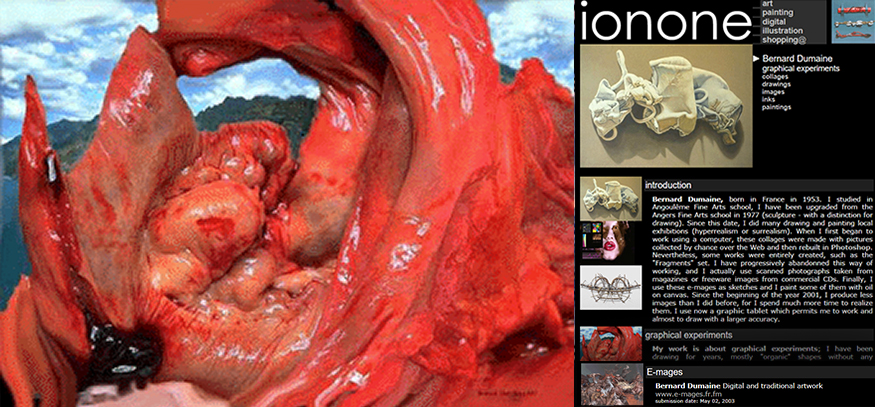
Bernard Dumaine, born in France in 1953. I studied in Angoulême Fine Arts school, I have been upgraded from the Angers Fine Arts school in 1977 (sculpture - with a distinction for drawing). Since this date, I did many drawing and painting local exhibitions (hyperrealism or surrealism). When I first began to work using a computer, these collages were made with pictures collected by chance over the Web and then rebuilt in Photoshop. Nevertheless, some works were entirely created, such as the "Fragments" set. I have progressively abandonned this way of working, and I actually use scanned photographs taken from magazines or freeware images from commercial CDs. Finally, I use these e-mages as sketches and I paint some of them with oil on canvas. Since the beginning of the year 2001, I produce less images than I did before, for I spend much more time to realize them. I use now a graphic tablet which permits me to work and almost to draw with a larger accuracy.
My work is about graphical experiments; I have been drawing for years, mostly "organic" shapes without any preliminary plan. Actually, I create pictures using Photoshop and I sometime use them as sketches to paint
www.e-mages.fr.fm
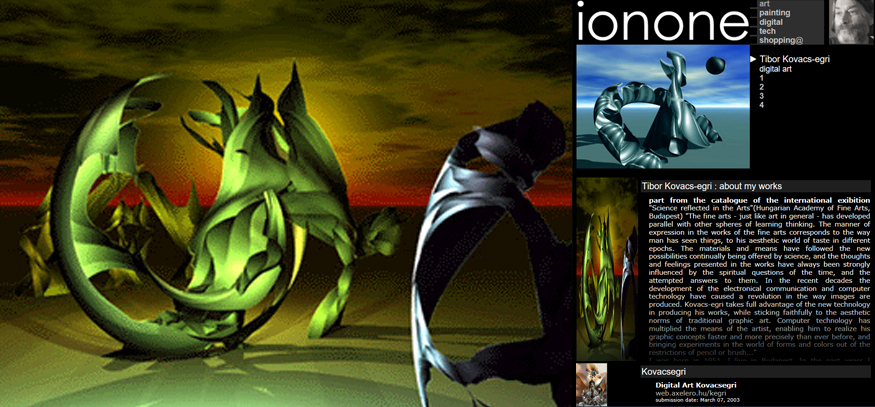
part from the catalogue of the international exibition "Science reflected in the Arts"(Hungarian Academy of Fine Arts, Budapest) "The fine arts - just like art in general - has developed parallel with other spheres of learning thinking. The manner of expression in the works of the fine arts corresponds to the way man has seen things, to his aesthetic world of taste in different epochs. The materials and means have followed the new possibilities continually being offered by science, and the thoughts and feelings presented in the works have always been strongly influenced by the spiritual questions of the time, and the attempted answers to them. In the recent decades the development of the electronical communication and computer technology have caused a revolution in the way images are produced. Kovacs-egri takes full advantage of the new technology in producing his works, while sticking faithfully to the aesthetic norms of traditional graphic art. Computer technology has multiplied the means of the artist, enabling him to realize his graphic concepts faster and more precisely than ever before, and bringing experiments in the world of forms and colors out of the restrictions of pencil or brush..."
I was born in 1951. I live in Budapest. In the past years I participated in different national and international exhibitions. My affiliation: Association of Hungarian Creative Artists.
web.axelero.hu/kegri

It is not my aim to create realistic reflections of my surrounding environment. I would rather like to show the things between and behind and to make my thoughts and perceptions visible. My works are frequently very strong related with personal and social conditions, experiences and emotions.
I was born in 1948 in Wiedenbrück, Germany. Since 1969 I'm married with the graphic designer Karl-Ludwig Kuhlmann. We live and work in Verl, Germany.
After leaving school in 1967 with a secondary degree I concluded a professional education as a photographer and graphic designer. At first I was an employee of Bertelsmann publishing house and worked some years in the publicity department of the Nobilia factory, a furniture and kitchens producer. Since 1976 I have been working as a freelancer for several publicity agencies and advertising departments and shaped every kind of publicity resources, like prospects, mailings, advertisements and product designs. As an example I cared for a club-journal for Radio Télé Luxemburg (RTL) for several years.
In 1994 I discovered the computer - which had been that far only a working tool, as my personal artistic medium. I gained the necessary knowledge for it in a self taught manner. Between 1994 and 2002 I extended my activities on three fields:
1. The graphic work with own photos: Digitally edited photo-collages of flowers and landscapes, frequently completed with paintings, expressing the connection between the perceptible picture and imagination. Most of them have been awarded in the annually hold Corel World Design Contest.
2. The work with 3D-programs: 3D-illustrations and landscapes in a surrealistic manner also digitally edited and supplemented with paintings.
3. Experimental and abstract works: Since beginning to use the computer as a personal artistic tool in 1994 I tended more and more towards abstraction. Especially the game with geometric forms and the research into the visual and emotional possibilities of several graphic methods are of great interest for me. i.g. to work with fractals which are always the visualized solution of a complex mathematical problem - but viewed in isolation of mathematical questions and contents they are graphic patterns as a snapshot of the infinity. Drawing by algorithmus depends widely on coincidence. However generating and selecting of dynamic forms, their editing and coloring, is based on what psychologists may call "subjective perception". Mathematical art is - although it seems to be a contradiction in terms - a very intuitive and individual kind of work.
My subjects are human relations as well as personal and social conditions. [ . ]
read more »
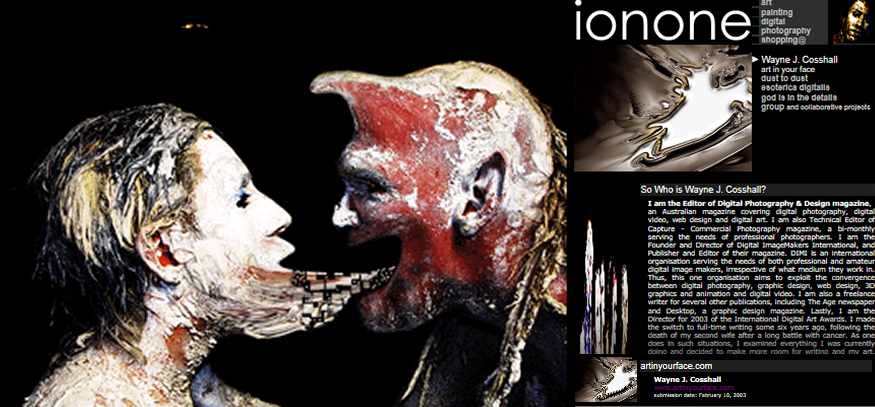
I am the Editor of Digital Photography & Design magazine,
an Australian magazine covering digital photography, digital video, web design and digital art. I am also Technical Editor of Capture - Commercial Photography magazine, a bi-monthly serving the needs of professional photographers. I am the Founder and Director of Digital ImageMakers International, and Publisher and Editor of their magazine. DIMI is an international organisation serving the needs of both professional and amateur digital image makers, irrespective of what medium they work in. Thus, this one organisation aims to exploit the convergence between digital photography, graphic design, web design, 3D graphics and animation and digital video. I am also a freelance writer for several other publications, including The Age newspaper and Desktop, a graphic design magazine. Lastly, I am the Director for 2003 of the International Digital Art Awards. I made the switch to full-time writing some six years ago, following the death of my second wife after a long battle with cancer. As one does in such situations, I examined everything I was currently doing and decided to make more room for writing and my art. Prior to this I was a Senior Lecturer in Computer Science at Swinburne University and Head of the Computer Graphics Research Group. I was an academic for 17 years there, specializing in parallel computer graphics rendering, computer architectures for graphics and mathematical and algorithmic art. I created my first computer graphics image in 1979, built my first computer in 1980 and constructed my first digital camera in 1986. Parallel to all this I was actively working on my photographic and art skills. I cut my teeth on photography as a child doing astrophotography, hooking my cameras up to the telescopes I had and built. This grew into a general interest in photography and art. I also started painting around the same time. It was during my time with my late wife that the passion for art photography and digital art really developed and I owe her a huge debt for guiding my development. I am now happily re-married and have a delightful daughter. I have exhibited my photography and digital art (predominantly mathematical and fractal imagery, up until quite recently) in group and solo shows within Australia, including invitational survey shows. My digital artwork is currently going through a period of major change and development. I also run a small graphic design and professional photography studio, with my wife and we also sell fine art materials to the local professional artists. My wife is a pastel, acrylic and oil painter (as was my late wife), and I paint in watercolours, mainly on Yupo plastic papers, as a relief from the computer work. My digital art work draws inspiration from my many interests. For my whole life I have had deep interests in, and made active studies of, philosophy, the esoteric, ancient history, esp. Egyptian, Greek, Roman and Celtic, comparative religions, mathematics, astronomy, quantum physics, paleontology, the origins of man, psychology, art and modern history, esp. European and Asian.
read more »
www.artinyourface.com

We Cyberartists have tunnel vision. Through our art, best fitted to the digital network that the spidery Web is, we pipeline our "cyber"-works for "cyber"-culture's sake that is globally prevalent. When I first established a presence on line with my "Truly Virtual Web Art Museum" in 1997, I had difficulty finding good digital art online to fill the virtual gallery spaces with international computer art. It was pretty much a vast e-wasteland. Cultural experience back then was more about taking up residency in free "home"-pages such as Geocities, and flirting in then novel online "chatrooms." But the Internet held the near term promise that scores of digital artists would soon arrive to claim this new realm of art opportunity. And yes, today, they pervasively inhabit this exciting, proliferating cyberspace! There is now such a diverse richness online of cyberarts that I am proud to be part of this pioneering first generation of artists that are providing culture unique to the Web. Here is art found nowhere else but on the Web.
"Cyberart," according to my perspective and mission, is digital art that is created exclusively for viewing, appreciation, and experiencing, on the Internet. Imagine the power to now be able to transport your feelings, ideas, as artist with anybody on the planet, bypassing the physical bottlenecks that museums and galleries are, through a democratic, distributive vehicle for public visibility and consumption. All one has to do is conform to the medium of expression that best fits this electronic modality, the computer, the network, the boxy screen. Not all artists, especially the sculptors, take naturally to this beckoning new art medium . But for me, like a fish to water, it was a logical extension from "computer artist" (1985-96) to "cyberartist" (1997- present). It just took a change of commitment from printing-framing-nailing-hanging-on-the-wall to merely uploading new works to my web pages. With the advent of this new portal for artistic visionaries, the Internet's Flash, Java, and multimedia integration developments guarantee future visual delights for all cybercitizens.
For 2002 a new milestone for all cyberartists - the EHCC World Tour of Cyberart www.lastplace.com/EXHIBITS/EHCC/ICE2002/ art of disciples for Internet Art- is downloaded, printed out, framed, and exhibited to reveal themselves to those who only "see" in the "real world"- outside the domain of online culture. With the stewardship of Ingrid Kamerbeek of Germany, it is our plan to establish a "web ring" of worldwide museums that recognize, and support, the virtues of Cyberart. Hopefully this will accelerate the pace of opening "unwired" eyes, leading the way to the hidden dimension of edge art just a fingertip away, lying buried, like hidden treasures, within the new landscape of ubiquitous desktops.
Pygoya (aka Rodney Chang, M.A., Ph.D) December 5, 2002
Rodney Chang, better known as the Internet's Pygoya, Cyberartist, was the first digital artist to exhibit in Honolulu, back in 1985. Since then he has exhibited around the world, including Paris, New York City, Russia, Germany, England, India, and Japan. His 1988 solo show at Shangahi Art Museum was China's historic first computer art exhibition. In 2002 Dr. Chang curated and organized East Hawaii Cultural Center's first International Cyberart Exhibition and World Tour. Through the 1980s-90s the artist completed his first major project of computer art (over 150 large painted canvases), "PaintOuts" (as in "printouts") or "Cyberpaintings", before dedicating his creative works solely to digital online display , as content for his virtual 3D museum, The Pygoya Webmuseum, established in 1997. His latest major contribution to the visual arts of the Web is "100 Cyberbabies" (as in new art born on the Internet) exhibition.
Currently the artist is curator and director for his online virtual reality Truly Virtual Web Art Museum, webmaster for Las Vegas Art Musuem Web site (until 2002) and the East Hawaii Cultural Center Pygoya made history in organizing and traveling to Calcutta for India's first ever international digital art exhibition (1999). In early 2002 Truly Virtual Web Art Museum proudly greeted its 1 millionth visitor.
The computer serves as assistant in discovering new art visions for Pygoya. The artist, over the years' parade of changing personal computer systems, always attempts to reinvent his developed "style" on the computer, as much his own input as the evolving technical tools. Then, instead of a hard copy printout that other computer artists exhibit and sell, an intermediary actual painting on canvas is produced to "dedigitize" the work This is done in order to remove a purely technical feeling of computer graphics, which some consider a bit "sterile". Then the working painting is photographed, "redigitalized" and modified through editing refinements by the artist. The "final" work of art are either Giclée or Epson archival inkjet prints or such derived digital cyberart is placed online for exhibition in Internet cyberspace virtual reality galleries, such as the 3DPygoya Webmuseum . Most recently, purely digital images are garnered from 3D software and posted as art created for the Internet to contribute to the global visual arts online cyberculture. As such Pygoya's 100 Cyberbabies in 2002 were inspired by the online life of the artist.
read more »

Pygoya about Ingrid Kamerbeek: "Born in 1952 in Gummersbach, Germany. Currently lives in the romantic area of Bavaria. The beautiful landscape not only attracts many foreign tourists worldwide but also provides inspiration for Kamerbeek's art. After high school the artist embarked on a very special education in graphic arts through tutelage and apprenticeship with her grandfather and father, two previous family generations of professional painters. Kamerbeek owned galleries in Kaarst near Düsseldorf (1978 - 1980) and in Mönchengladbach (1980 - 1982) before creating her own web site which assists other cyberartists to gain exposure for their work. A true inspirational leader and motivator for the cyberarts. Much art exhibiting, on earth and in cyberspace. One of her works, "Global Consciousness", was inducted recently into the online Cyberculture Art Museum. The artist finds time to maintain the position of Co-coordinator for East Hawaii Cultural Center's International Cyberart World Tour and Coordinator of CenterofCyberspace.com". read more »
www.artingrid.de
Universal symbols from all cultures, representing everything from festive pinwheels to the internal journey of the soul. The Spiral: A movement down into despair, a motion up into joy, a sojourn inward and back out again. The Circle: A path of completion, a new beginning, a continuing sense of union. "For the past number of years I have been exploring in my photography these two symbols, creating them in sand, in flame in water, in time. Each time I learn a little more about the space I am in, both emotionally internal to my experiences, and physically external to my environment. This series is as much about the exploration of my spiritual reality, as it is about an appreciation of form, shape, and design."
stujenks.com

I've been conjuring images in some form or fashion for the vast majority of my life. After a 24 year break working as air traffic controller in the Air Force I've once again managed to return to my creative roots on a full time basis. I did perform a considerable amount of freelance commercial work in Japan as well as the odd portrait commission before leaving the service. I've worked in every sort of medium and finally devoted myself to digital imaging a little over 2 years ago. Web design for me is akin to painful and protracted dental work.
www.logiquenoir.com

In today's challenging business environment, Adobe Photoshop 7.0 helps you stay competitive with innovative tools that deliver new ways to express your creativity and work efficiently. With Photoshop 7.0, you can more easily produce exceptional imagery for print, the Web, wireless devices, and other media. Photoshop 7.0 rounds out its comprehensive toolset with new capabilities to meet any creative or production demand and to handle the widest variety of image-editing tasks in the most efficient way. With enhanced Web features, you can instantly make Web page elements transparent simply by knocking out one or more colors; create dithered transparencies; manage Web page rollovers and animations; and create more sophisticated Web rollovers. Powerful new tools help you explore your creativity without limits so you can more easily meet the multimedia demands of today's market. Simulate traditional painting techniques (including pastels and charcoal) with dry and wet brush effects and use brushes to add special effects. Adjust dozens of precise brush settings including size, shape, and tilt to create custom brushes that you can share with other Photoshop users. With the new Pattern Maker plug-in, you can select any area of an image and automatically generate a nearly endless assortment of background patterns. And the enhanced Liquify plug-in lets you distort images more easily and gain greater control over warping. Photoshop 7.0 offers unparalleled precision and control so you can be confident you're achieving consistently superior output. New security features let you restrict access to your images with password protection.
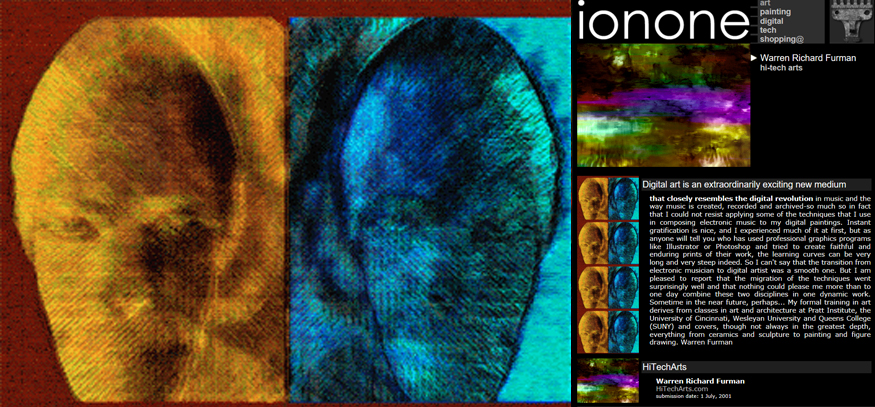
Digital art is an extraordinarily exciting new medium that closely resembles the digital revolution in music and the way music is created, recorded and archived-so much so in fact that I could not resist applying some of the techniques that I use in composing electronic music to my digital paintings. Instant gratification is nice, and I experienced much of it at first, but as anyone will tell you who has used professional graphics programs like Illustrator or Photoshop and tried to create faithful and enduring prints of their work, the learning curves can be very long and very steep indeed. So I can't say that the transition from electronic musician to digital artist was a smooth one. But I am pleased to report that the migration of the techniques went surprisingly well and that nothing could please me more than to one day combine these two disciplines in one dynamic work. Sometime in the near future, perhaps... My formal training in art derives from classes in art and architecture at Pratt Institute, the University of Cincinnati, Wesleyan University and Queens College (SUNY) and covers, though not always in the greatest depth, everything from ceramics and sculpture to painting and figure drawing. Warren Furman
web.axelero.hu/kegri
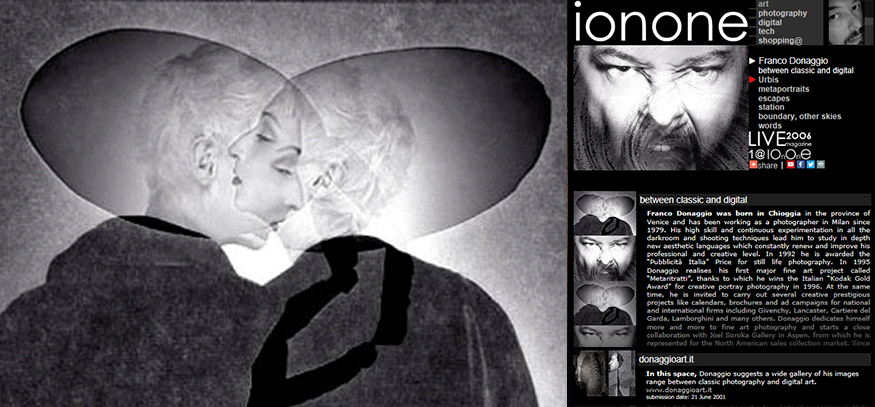
Franco Donaggio was born in Chioggia in the province of Venice and has been working as a photographer in Milan since 1979. His high skill and continuous experimentation in all the darkroom and shooting techniques lead him to study in depth new aesthetic languages which constantly renew and improve his professional and creative level. In 1992 he is awarded the “Pubblicità Italia” Price for still life photography. In 1995 Donaggio realises his first major fine art project called “Metaritratti”, thanks to which he wins the Italian “Kodak Gold Award” for creative portray photography in 1996. At the same time, he is invited to carry out several creative prestigious projects like calendars, brochures and ad campaigns for national and international firms including Givenchy, Lancaster, Cartiere del Garda, Lamborghini and many others. Donaggio dedicates himself more and more to fine art photography and starts a close collaboration with Joel Soroka Gallery in Aspen, from which he is represented for the North American sales collection market. Since then, he has attended the principal photo-art trade fairs through the United States, such as 'Photo LA', Los Angeles, 'AIPAD show', New York, 'Art Fair, Chicago'. Donaggio’s fine art works have been hosted in numerous Italian galleries and museums and some of his photographs are included in several public and private photo collections: Bibliothèque Nationale de France, Collezione 3M, Collezione Scavi Scaligeri, Saudi Royal Family’s Private Collection, to name just a few. Lots of magazines in Italy, Europe and United States have published the artist’s creative profile. Donaggio is represented by the ‘Joel Soroka Gallery’ in Aspen, by the ‘Benham Gallery’ in Seattle and by the Galerie Celal in Paris for the fine art sale in the United States. read more »
www.francodonaggio.it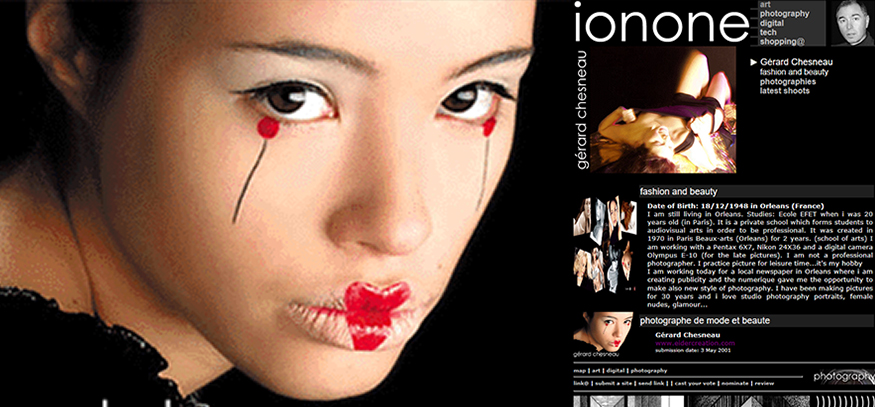
Date of Birth: 18/12/1948 in Orleans (France).
I am still living in Orleans. Studies: Ecole EFET when i was 20 years old (in Paris). It is a private school which forms students to audiovisual arts in order to be professional. It was created in 1970 in Paris Beaux-arts (Orleans) for 2 years. (school of arts) I am working with a Pentax 6X7, Nikon 24X36 and a digital camera Olympus E-10 (for the late pictures). I am not a professional photographer. I practice picture for leisure time...it's my hobby
I am working today for a local newspaper in Orleans where i am creating publicity and the numerique gave me the opportunity to make also new style of photography. I have been making pictures for 30 years and i love studio photography portraits, female nudes, glamour ...
read more »

The work of photographer Agnes Donnadieu has been called brooding and sexy, edgy and glamorous, erotic and slick. It's also been called "European." What nobody has ever called it is "Midwestern," though Donnadieu has lived and worked in Chicago for the last 9 years. Donnadieu's photos tend to be dark and shadowy. Her images of people appear unposed, yet the composition is graphic, candid, without being contrived. The dramatic look of her photos is due in part to her direct lighting technique. read more »
www.donnadieustudio.com